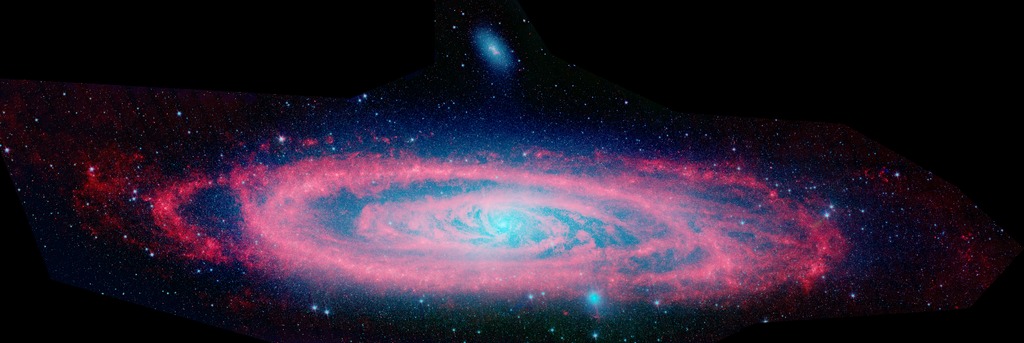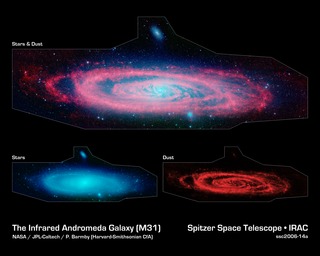
Credit: NASA/JPL-Caltech/P. Barmby (Harvard-Smithsonian CfA)
Observation • June 5th, 2006 • ssc2006-14a1
ssc2006-14a1
This infrared composite image from NASA's Spitzer Space Telescope shows the Andromeda galaxy, a neighbor to our Milky Way galaxy. The image highlights the contrast between the galaxy's choppy waves of dust (red) and smooth sea of older stars (blue).
The Spitzer view also shows Andromeda's dust lanes twisting all the way into the center of the galaxy, a region that is crammed full of stars. In visible-light pictures, this central region tends to be dominated by starlight.
Astronomers used these new images to measure the total infrared brightness of Andromeda. Because the amount of infrared light given off by stars depends on their masses, the brightness measurements provided a novel method for "weighing" the Andromeda galaxy. According to this method, the mass of the stars in Andromeda is about110 billion times that of the sun, which is in agreement with past calculations. This means the galaxy contains about one trillion stars (because most stars are actually less massive than the sun). For comparison, the Milky Way is estimated to hold about 400 billion stars.
A small, companion galaxy called NGC 205 is visible above Andromeda. Another companion galaxy called M32 can also been seen below the galaxy.
The Andromeda galaxy, also known affectionately by astronomers as Messier 31, is located 2.5 million light-years away in the constellation Andromeda. It is the closest major galaxy to the Milky Way, making it the ideal specimen for carefully examining the nature of galaxies. On a clear, dark night, the galaxy can be spotted with the naked eye as a fuzzy blob.
Andromeda's entire disk spans about 260,000 light-years, which means that a light beam would take 260,000 years to travel from one end of the galaxy to the other. By comparison, the Milky Way is about 100,000 light-years across. When viewed from Earth, Andromeda occupies a portion of the sky equivalent to seven full moons.
Because this galaxy is so large, the infrared images had to be stitched together out
About the Object
- Name
- Andromeda Galaxy • Messier 31 • M31 • NGC 224 • Messier 32 • M32 • Messier 110 • M110
- Type
- Galaxy > Type > Spiral
- Distance
- 2,500,000 Light Years
Color Mapping
| Band | Wavelength | Telescope |
| Infrared | 3.6 µm | Spitzer IRAC |
| Infrared | 4.5 µm | Spitzer IRAC |
| Infrared | 8.0 µm | Spitzer IRAC |
Astrometrics
- Position (J2000)
- RA =0h 41m 53.4s
- Dec = 41° 21' 56.7"
- Field of View
- 3.5 x 1.2 degrees
- Orientation
- North is 50.0° left of vertical







